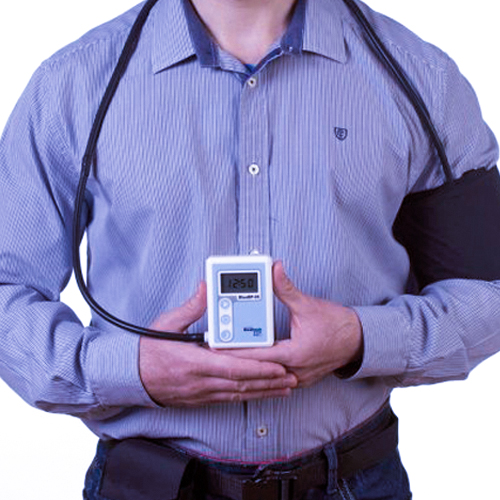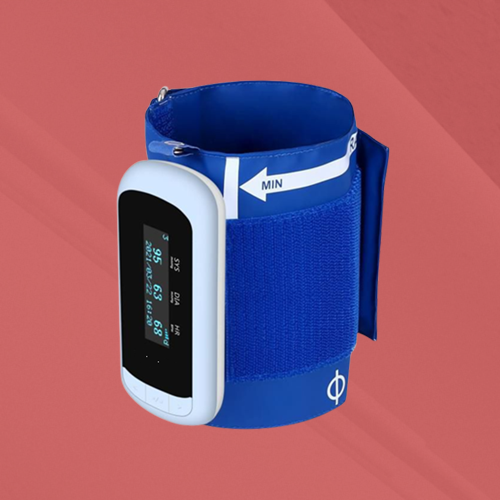The Benefits of the ABPM Test for Accurate Blood Pressure Assessment
Ambulatory Blood Pressure Monitoring (ABPM) provides an advanced strategy to evaluating blood pressure. This technique offers continuous, 24-hour information, recording variations that happen throughout everyday activities and sleep. Such in-depth monitoring not only enhances accuracy yet additionally reveals important patterns, helping to compare real high blood pressure and conditions like white-coat syndrome. Recognizing these subtleties can cause a lot more efficient treatment methods. What implications might this have for individual treatment and management?
What Is Ambulatory Blood Pressure Monitoring (ABPM)?
Ambulatory Blood Pressure Monitoring (ABPM) is an approach that enables constant blood pressure analysis over a 24-hour period, offering a substantial photo of an individual's high blood pressure fluctuations. ABPM test in Bangalore. This technique utilizes a mobile device that instantly measures high blood pressure at regular intervals throughout the day and night. As individuals go about their everyday tasks, the gadget records information showing their high blood pressure variants throughout various times and conditions, consisting of rest and physical exertion.ABPM is particularly advantageous for identifying conditions such as high blood pressure, as it can compare true hypertension and white-coat syndrome, where individuals display elevated readings in clinical setups but not in their daily lives. By supplying a thorough view of blood stress adjustments, ABPM help doctor in making notified choices pertaining to medical diagnosis and treatment. It improves the understanding of blood stress patterns, allowing tailored administration methods for clients.
Continual Monitoring for Improved Accuracy
Constant monitoring of high blood pressure through ABPM greatly improves the precision of analyses compared to conventional techniques. This method allows for high blood pressure measurements at routine periods throughout the day and night, capturing changes that might take place because of everyday activities, tension, or various other factors. Unlike solitary readings taken during a facility go to, ABPM offers a detailed profile of a client's blood pressure over a 24-hour period.This constant analysis causes extra reputable information, making it possible for health care service providers to identify patterns and potential issues that might go unnoticed with sporadic measurements. It likewise helps distinguish between real high blood pressure and white-coat syndrome, where patients exhibit elevated readings as a result of anxiety in a clinical setup. By leveraging the advantages of constant monitoring, ABPM considerably enhances diagnosis and treatment approaches, inevitably adding to much better client results and more customized medical care approaches.
Comprehending Blood Pressure Irregularity
Blood pressure variability refers to the variations in high blood pressure analyses that can occur over time as a result of different factors, consisting of physical activity, anxiety, and circadian rhythms. This irregularity is substantial as it supplies insights right into a person's cardiovascular wellness. ABPM test in Bangalore. For example, factors such as workout can briefly enhance high blood pressure, while relaxation might lead to a decrease. Furthermore, the body's all-natural rhythms can trigger blood stress to differ throughout the day, usually being lower in the evening and greater throughout waking hours. High degrees of irregularity have actually been related to boosted threats of cardiovascular occasions, making it important for medical care specialists to monitor these changes. Comprehending blood stress variability assists in tailoring treatment strategies and examining overall wellness. Exact evaluation via approaches like Ambulatory High blood pressure Monitoring (ABPM) can capture these variations, enabling a much more thorough assessment of a patient's blood pressure account
Recognizing White Coat Hypertension
White coat high blood pressure, frequently described as white layer syndrome, is defined by raised high blood pressure analyses in medical settings due to anxiety or stress. Acknowledging its signs and symptoms and indicators is important for precise medical diagnosis, as misconception can lead to unneeded therapies. Recognizing this sensation is crucial for reliable high blood pressure administration and client treatment.
Comprehending White Coat Disorder
Although several people exhibit raised blood pressure readings in medical settings, this phenomenon, called white coat hypertension, can obscure the true state of their cardiovascular health and wellness. This problem occurs when individuals experience anxiety or anxiety during medical gos to, causing temporary spikes in blood stress. Consequently, health care service providers may misinterpret these readings as a sign of hypertension. White layer syndrome highlights the significance of accurate blood stress evaluation, as relying exclusively on in-office measurements can bring about unnecessary therapies or false impressions about an individual's health and wellness. Understanding this syndrome is crucial for clinicians, as it highlights the demand for different monitoring techniques, such as ambulatory blood pressure monitoring (ABPM), to acquire an extra exact representation of a person's blood pressure levels.
Signs and Indicators
Several people might experience certain symptoms that recommend the visibility of white layer hypertension. These signs can consist of elevated high blood pressure readings throughout clinical sees, accompanied by feelings of stress and anxiety or anxiety in a professional setting. People often report a rapid heartbeat or sweating when engaging with medical care specialists, which may exacerbate their high blood pressure levels. In addition, some people may observe a difference between their in-office high blood pressure readings and those taken at home, where they feel much more unwinded. Acknowledging these signs and symptoms is important, as they can show that stress or stress and anxiety relevant to clinical setups is influencing their blood stress. Recognizing these indications can aid in determining white coat hypertension and determining the requirement for further assessment.

Significance of Accurate Medical Diagnosis
Precisely identifying white layer high blood pressure is essential for effective high blood pressure monitoring. This condition happens when an individual shows elevated high blood pressure analyses in a clinical setting due to anxiety or stress, while normal analyses are taped in a much more kicked back atmosphere. Misdiagnosis can lead to unnecessary treatment, revealing patients to potential medication negative effects with no genuine health advantage. The usage of ambulatory blood stress monitoring (ABPM) is essential in identifying real high blood pressure from white layer syndrome. ABPM supplies constant blood stress measurements over 24 go to my blog hr, enabling a complete analysis that can help health care carriers make educated choices. Eventually, precise identification of white coat hypertension assurances clients receive appropriate treatment and prevents the challenges of mismanagement.
Examining Nocturnal Blood Pressure Patterns
Assessing nighttime blood pressure patterns is crucial for comprehending a person's total cardiovascular health. Nighttime dimensions can reveal considerable fluctuations in blood stress, which might show high blood pressure variability. In addition, these patterns are very closely associated with heart wellness, highlighting the importance of continual monitoring past typical workplace brows through.
Value of Evening Measurements

Nighttime high blood pressure measurements are frequently important for recognizing an individual's total cardiovascular health. These readings supply crucial understandings into how high blood pressure behaves throughout rest, which can differ significantly from daytime levels. Keeping track of nighttime high blood pressure enables the identification of unusual patterns, such as non-dipping or reverse-dipping sensations, YOURURL.com which may suggest an increased danger for cardio occasions. On top of that, nighttime analyses can help examine the effectiveness of antihypertensive therapies, making certain that medications are properly taken care of. By capturing high blood pressure modifications throughout the evening, healthcare experts can develop extra personalized treatment strategies, inevitably improving patient results and lowering the chance of lasting complications connected with hypertension. This highlights the relevance of thorough blood pressure analysis throughout the day and evening.
Spotting Hypertension Variability
Exactly how can the variability of nighttime high blood pressure patterns inform hypertension management? The evaluation of nocturnal high blood pressure via the Ambulatory Blood Pressure Monitoring (ABPM) test discloses essential variations that commonly go unnoticed in traditional dimensions. These patterns can indicate the presence of "non-dipping" hypertension, where high blood pressure fails to go down throughout rest, recommending a raised cardio danger. By recognizing such irregularity, healthcare carriers can customize treatments a lot more efficiently, changing therapy strategies based upon the individual's specific nighttime high blood pressure actions. Recognizing these patterns likewise help in examining the efficacy of antihypertensive medicines, ensuring that people achieve ideal high blood pressure control click resources throughout the day and evening. Subsequently, nighttime evaluation becomes essential in thorough high blood pressure administration.
Relationship With Heart Health
Recognizing nighttime high blood pressure patterns not just aids in hypertension administration however additionally has significant implications for heart wellness. Research study indicates that unusual nighttime high blood pressure readings, such as non-dipping or reverse dipping patterns, are associated with raised cardiovascular threats. During sleep, blood stress normally decreases, a sensation important for cardio recovery. When this decline is lacking, it may signal underlying problems such as free dysfunction or boosted arterial rigidity. Additionally, people with raised nighttime blood pressure are at an increased threat for cardiac arrest and stroke. Consequently, using ambulatory blood stress monitoring (ABPM) to analyze these nighttime patterns can provide important insights, permitting customized interventions that much better shield heart wellness and improve overall individual results.
Tailoring Therapy Plans Based on Real-Life Information
Customizing treatment strategies based on real-life data involves leveraging continuous high blood pressure keeping an eye on to develop customized medical care strategies. The Ambulatory Blood Pressure Monitoring (ABPM) test offers a complete account of a client's high blood pressure variations throughout daily activities. This comprehensive data permits doctor to recognize patterns that could be ignored in typical workplace visits.By examining fluctuations in high blood pressure during different times and problems, medical professionals can adjust drugs, does, and way of life recommendations to better fit individual patient demands. This customized approach not only enhances the performance of therapy strategies but also minimizes the possibility of damaging responses to medications.Furthermore, real-life data can disclose prospective triggers for hypertension, leading to aggressive interventions. On the whole, tailoring therapy based on continual monitoring promotes a more efficient, patient-centered technique to taking care of hypertension and enhancing long-lasting health results.
Improved Patient Conformity and Interaction
While conventional monitoring approaches might restrict person participation, making use of Ambulatory Blood Stress Monitoring (ABPM) considerably enhances individual compliance and interaction in their own health care. By allowing people to put on a mobile gadget that records high blood pressure over 24-hour, ABPM empowers individuals to take an active function in their health management. This continuous monitoring gives a more complete sight of high blood pressure changes, encouraging people to understand their condition better.Moreover, ABPM fosters an environment where clients can review their analyses with doctor extra meaningfully, leading to informed decision-making. Patients end up being much more bought sticking to recommended treatments and lifestyle modifications when they see real-time data showing their wellness status. As a result, the shift from passive individual to energetic collaborator not just enhances compliance but likewise improves general health and wellness results, making ABPM a beneficial tool in promoting person involvement in high blood pressure monitoring.
Regularly Asked Inquiries
How much time Does an ABPM Examination Commonly Last?
The ABPM examination commonly lasts 24-hour. During this period, it gauges high blood pressure at regular intervals, offering a detailed analysis of an individual's high blood pressure patterns throughout their day-to-day tasks and rest.
Are There Any Type Of Threats Connected With ABPM Screening?

Can ABPM Be Made Use Of for Children and Teenagers?
ABPM can be made use of for kids and adolescents, giving crucial insights into their high blood pressure patterns. Correct tools sizing and analysis by trained specialists are necessary to ensure accurate analyses and avoid misdiagnosis.
Just How Is ABPM Different From Standard Blood Pressure Monitoring?
ABPM differs from typical monitoring by supplying continual high blood pressure analyses over 24 hours, recording variants throughout everyday activities and rest, whereas standard techniques usually count on solitary dimensions, possibly missing essential changes in high blood pressure.
What Should Individuals Do Throughout the ABPM Test?
During the ABPM test, patients ought to keep regular tasks while staying clear of hefty workout, extreme caffeine, and cigarette smoking. They must also maintain their arm still when the device inflates, guaranteeing exact analyses throughout the monitoring period.